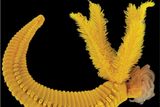Now Reading: Golden-Hued Worm’s Toxicity: A Deep-Sea Survival Secret
-
01
Golden-Hued Worm’s Toxicity: A Deep-Sea Survival Secret
Golden-Hued Worm’s Toxicity: A Deep-Sea Survival Secret

Rapid Summary
- Key Findings: A deep-sea worm species, Paralvinella hessleri, thrives in extreme and toxic environments by using a unique detoxification process.
- Habitat: These worms live in mineral-rich hydrothermal vents in the west Pacific Ocean, enduring high temperatures and hazardous levels of arsenic and sulfide.
- Adaptation Mechanism: The worms neutralize arsenic and sulfides through a biomineralization process that converts toxic substances into less harmful clumps of orpiment, a golden pigment. This adaptation allows survival while deterring predators and competitors.
- Scientific Revelation: Advanced microscopy combined with DNA, protein, and chemical analyses uncovered this previously unknown detoxification strategy. Almost 1 percent of the worm’s body weight consists of arsenic particles involved in this process.
- Appearance: The accumulation of orpiment provides the worm with its distinctive bright yellow coloring.
Indian Opinion Analysis
The captivating revelation about Paralvinella hessleri exemplifies how life can adapt to extreme chemical environments. While primarily focused on marine biology, findings like these can potentially inspire further exploration into bioengineering solutions for pollution management or industrial applications using natural detoxification processes. For India-home to diverse ecosystems including coastal areas-such adaptive mechanisms might open doors to better understanding how organisms interact with toxins in challenging habitats like polluted rivers or industrial zones.
additionally, this research reinforces the importance of international collaboration in deep-sea exploration for comprehending Earth’s biodiversity as well as uncovering natural innovations at microscopic levels. India’s own advancements coudl benefit from investing resources into such studies to tackle ecological challenges while fostering global scientific partnerships.Read More

























